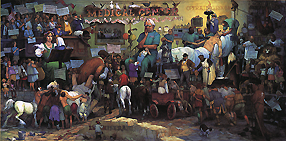
A Day in the Hospital

A Day in the Hospital by Jose Perez
(Oil on Canvas, 48 in x 96 in, 123 cm x 246 cm)
Copyright: This image may not be saved locally, modified, reproduced, or distributed by any other means without the written permission of the copyright owners.
This masterfully complex painting sets the stage for Perez' series on medicine. It is not just a story about doctors, because Perez does not treat medicine as the exclusive turf of doctors. Rather, it shows the inescapable relationships between healers, sufferers, disease, and death. The conglomerate that brings these components together is what we call our health-care system. This painting holds up a mirror to the very essence of the system -- our hospitals.
After focusing on the large, central doctor, one's eye is tempted to move in all directions to scenes and sub-scenes throughout the canvas. But, if you will, first look at the doctor's facial expression and body language. This very human figure seems to be wondering what in the world he should do with all the suffering humanity he confronts.
The patient on the operating table -- who looks as if he's just about to expire -- is getting a lot of attention from the medical staff. Merlin the Magician is positioned next to the patient, perhaps to help him cross the River Styx. Is all this care too late? Would it be wiser to free up the doctors to help patients with better chances of survival?
The priest-like fellow in the purple robe holds a burning candle, perhaps trying to shed light on the situation, or maybe suggesting that modern medicine is closer to that of past centuries then we like to think. One hundred years from now, will blood transfusions, scalpels, and radiation-scattering X-rays seem as primitive as bleeding and purging seem to us? Will the depersonalized treatment of patients -- shown by the robot being oiled -- result in robot-like people, who take no responsibility for their own care?
Animal rights activists will identify with the orangutan holding the placard, while the children below him remind us that children have rights, too, and not to be abused is one of those rights.
As the Grim Reaper in the lower right-hand corner comes to claim his prey, we realize that the wisdom of Solomon could not solve the needs of modern society with all its pressure groups, here shown by the demonstrators in the hall balcony. Perez himself is seen painting on a crumbling wall the words, "Les Miserables," an apt description of the patients in our system, and something of a double entendre: Perez' daughter spent two years traveling with the Broadway musical of that name.
Last Reviewed: May 11, 2012

